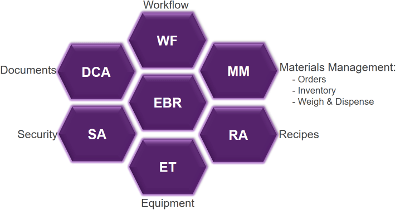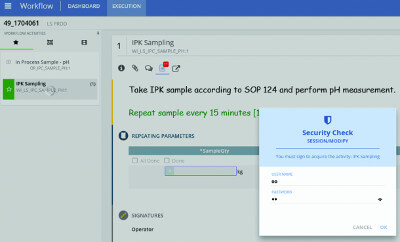The pharmaceutical and biotechnology manufacturing industries are challenged with errors in manual entries in the production process, getting batches right the first time, reaching final signoff for batch release, and managing the data accumulated throughout the production process.
I caught up with Emerson’s Mary Sowders about some of these challenges and the way they are being addressed. Mary shared with me that the move to electronic batch records (EBRs) and automated workflows from paper-based record keeping are significant steps in improving manufacturing performance. A manufacturing execution system (MES), such as Syncade, consists of several important functional areas. The central aspect of an MES is Electronic Batch Record Management (EBR). EBR delivers a holistic view of all activities throughout a batch and includes the following components:
A manufacturing execution system (MES), such as Syncade, consists of several important functional areas. The central aspect of an MES is Electronic Batch Record Management (EBR). EBR delivers a holistic view of all activities throughout a batch and includes the following components:
- Materials Management for material masters, orders, inventory, and weigh & dispense
- Recipe Authoring for designing recipes
- Equipment Tracking for managing states, events, procedures
- Security and Audit for configuring users and permissions
- Document Management for storage of recipes, standard operating procedures (SOPs), and batch records
- Workflow for running batches and procedures
Enhancements to Syncade Workflow were recently announced. As with many other technology developments over the past several years, a human-centered design approach was taken to improve user experience, deliver quick access to key tasks, and enhance security. Some of these enhancements included easier access to embedded step-by-step instructions for operators to improve repeatability of batch execution. These work instructions are archived as they are executed to become part of the electronic record.
 From a security standpoint, both unit testing and integrated testing have been implemented to help assure levels of security are built both into the application as well as layered in the architecture.
From a security standpoint, both unit testing and integrated testing have been implemented to help assure levels of security are built both into the application as well as layered in the architecture.
Mary noted that operators have better visibility into the process and flexible viewing options, including tablets, laptops and desktop environments. The execution screen provides access to a list of all activities within the batch, sequential function charts (SFCs), future activities, and executed activities. Collaboration among the operations staff is also improved with the addition of threaded comments in the execution of the workflow.
Mary summarized the key improvements as improving operational efficiency and batch execution effectiveness. The speed of activity completion is increased as is the clarity of instructions the operators should follow throughout the batch manufacturing process.
You can connect and interact with other manufacturing execution system and operations management experts in the Operations Management group in the Emerson Exchange 365 community.





